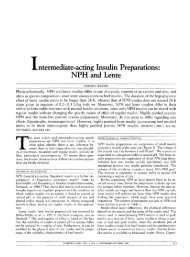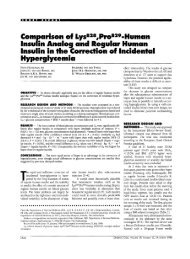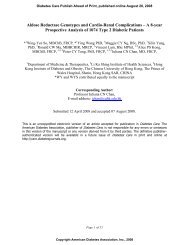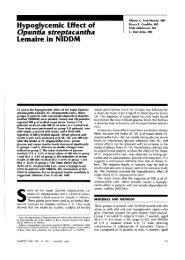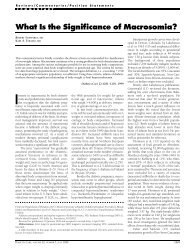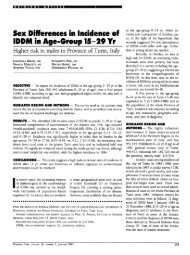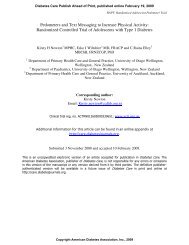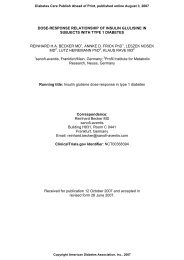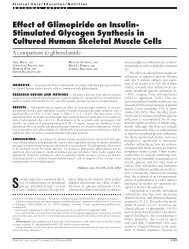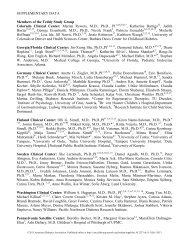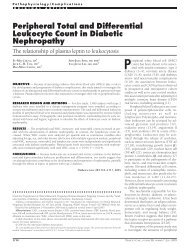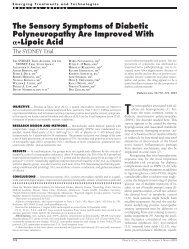Randomized Study of Basal-Bolus Insulin Therapy ... - Diabetes Care
Randomized Study of Basal-Bolus Insulin Therapy ... - Diabetes Care
Randomized Study of Basal-Bolus Insulin Therapy ... - Diabetes Care
Create successful ePaper yourself
Turn your PDF publications into a flip-book with our unique Google optimized e-Paper software.
Clinical <strong>Care</strong>/Education/Nutrition/Psychosocial Research<br />
O R I G I N A L A R T I C L E<br />
<strong>Randomized</strong> <strong>Study</strong> <strong>of</strong> <strong>Basal</strong>-<strong>Bolus</strong> <strong>Insulin</strong><br />
<strong>Therapy</strong> in the Inpatient Management <strong>of</strong><br />
Patients With Type 2 <strong>Diabetes</strong><br />
(RABBIT 2 Trial)<br />
GUILLERMO E. UMPIERREZ, MD 1<br />
DAWN SMILEY, MD 1<br />
ARIEL ZISMAN, MD 2<br />
LUZ M. PRIETO, MD 2<br />
ANDRES PALACIO, MD 1<br />
MIGUEL CERON, MD 1<br />
ALVARO PUIG, MD 2<br />
ROBERTO MEJIA, PHD 1<br />
OBJECTIVE — We sought to study the optimal management <strong>of</strong> hyperglycemia in non–<br />
intensive care unit patients with type 2 diabetes, as few studies thus far have focused on the<br />
subject.<br />
RESEARCH DESIGN AND METHODS — We conducted a prospective, multicenter,<br />
randomized trial to compare the efficacy and safety <strong>of</strong> a basal-bolus insulin regimen with that <strong>of</strong><br />
sliding-scale regular insulin (SSI) in patients with type 2 diabetes. A total <strong>of</strong> 130 insulin-naive<br />
patients were randomized to receive glargine and glulisine (n 65) or a standard SSI protocol<br />
(n 65). Glargine was given once daily and glulisine before meals at a starting dose <strong>of</strong> 0.4 units<br />
kg 1 day 1 for blood glucose 140–200 mg/dl or 0.5 units kg 1 day 1 for blood glucose<br />
201–400 mg/dl. SSI was given four times per day for blood glucose 140 mg/dl.<br />
RESULTS — The mean admission blood glucose was 229 6 mg/dl and A1C 8.8 2%. A<br />
blood glucose target <strong>of</strong> 140 mg/dl was achieved in 66% <strong>of</strong> patients in the glargine and glulisine<br />
group and in 38% <strong>of</strong> those in the SSI group. The mean daily blood glucose between groups<br />
ranged from 23 to 58 mg/dl, with an overall blood glucose difference <strong>of</strong> 27 mg/dl (P 0.01).<br />
Despite increasing insulin doses, 14% <strong>of</strong> patients treated with SSI remained with blood glucose<br />
240 mg/dl. There were no differences in the rate <strong>of</strong> hypoglycemia or length <strong>of</strong> hospital stay.<br />
CONCLUSIONS — Treatment with insulin glargine and glulisine resulted in significant<br />
improvement in glycemic control compared with that achieved with the use <strong>of</strong> SSI alone. Our<br />
study indicates that a basal-bolus insulin regimen is preferred over SSI in the management <strong>of</strong><br />
non–critically ill, hospitalized patients with type 2 diabetes.<br />
Hyperglycemia in hospitalized patients<br />
is a common, serious, and<br />
costly health care problem with<br />
pr<strong>of</strong>ound medical consequences. Increasing<br />
evidence indicates that the development<br />
<strong>of</strong> hyperglycemia during acute<br />
medical or surgical illness is not a physiologic<br />
or benign condition but is a marker<br />
<strong>Diabetes</strong> <strong>Care</strong> 30:2181–2186, 2007<br />
<strong>of</strong> poor clinical outcome and mortality<br />
(1–3). Extensive evidence from observational<br />
studies, including our own, indicates<br />
that in hospitalized patients with<br />
critical illness, hyperglycemia is associated<br />
with an increased risk <strong>of</strong> complications<br />
and mortality (3–9). Prospective<br />
randomized trials in critically ill patients<br />
●●●●●●●●●●●●●●●●●●●●●●●●●●●●●●●●●●●●●●●●●●●●●●●●●<br />
From the 1 Emory University School <strong>of</strong> Medicine, Atlanta, Georgia; and the 2 University <strong>of</strong> Miami School <strong>of</strong><br />
Medicine, Miami, Florida.<br />
Address correspondence and reprint requests to Guillermo E. Umpierrez, MD, Associate Director, General<br />
Clinical Research Center, Emory University School <strong>of</strong> Medicine, Grady Health System, 49 Jesse Hill Jr. Dr.,<br />
Atlanta, GA 30303. E-mail: geumpie@emory.edu.<br />
Received for publication 22 February 2007 and accepted in revised form 7 May 2007.<br />
Published ahead <strong>of</strong> print at http://care.diabetesjournals.org on 18 May 2007. DOI: 10.2337/dc07-0295.<br />
Clinical trial reg. no. NCT00394407, clinicaltrials.gov.<br />
Abbreviations: SSI, sliding-scale regular insulin.<br />
A table elsewhere in this issue shows conventional and Système International (SI) units and conversion<br />
factors for many substances.<br />
© 2007 by the American <strong>Diabetes</strong> Association.<br />
The costs <strong>of</strong> publication <strong>of</strong> this article were defrayed in part by the payment <strong>of</strong> page charges. This article must therefore be hereby<br />
marked “advertisement” in accordance with 18 U.S.C. Section 1734 solely to indicate this fact.<br />
See Editorial by Kitabchi and Nyenwe, p. 2409.<br />
have shown that intensive glucose control<br />
reduces the risk <strong>of</strong> multiorgan failure, systemic<br />
infections, and short- and longterm<br />
mortality. Effective management <strong>of</strong><br />
hyperglycemia is also associated with a<br />
decreased length <strong>of</strong> intensive care unit<br />
and hospital stay (4,6,8–10) and decreased<br />
total hospitalization cost (11).<br />
The importance <strong>of</strong> glycemic control on<br />
outcome is not limited to patients in critical<br />
care areas but also applies to patients<br />
admitted to general surgical and medical<br />
wards. In such patients, the presence <strong>of</strong><br />
hyperglycemia has been associated with<br />
prolonged hospital stay, infection, disability<br />
after hospital discharge, and death<br />
(1,5,12). In general surgery patients, the<br />
relative risk for serious postoperative infections<br />
(sepsis, pneumonia, and wound<br />
infection) increased 5.7-fold when any<br />
postoperative day 1 blood glucose was<br />
220 mg/dl (12). More recently, studies<br />
in patients with community-acquired<br />
pneumonia reported that hyperglycemia<br />
was associated with increased risk <strong>of</strong> inhospital<br />
complications and mortality<br />
(13,14).<br />
<strong>Insulin</strong>, given either intravenously as<br />
a continuous infusion or subcutaneously,<br />
is the most effective agent for immediate<br />
control <strong>of</strong> hyperglycemia in the hospital.<br />
In the critical care setting, a variety <strong>of</strong> continuous<br />
insulin infusion protocols have<br />
been shown to be effective in achieving<br />
glycemic control, with a low rate <strong>of</strong> hypoglycemic<br />
events, and in improving hospital<br />
outcomes (6,10,15). In general<br />
medicine and surgery services, however,<br />
hyperglycemia is frequently overlooked<br />
and inadequately addressed. Several reports<br />
from academic institutions have<br />
shown that most patients are treated with<br />
SSI and that basal insulin is prescribed in<br />
less than one-half <strong>of</strong> patients (16,17). Few<br />
clinical trials have focused on the optimal<br />
management <strong>of</strong> inpatient hyperglycemia<br />
in the noncritical setting. Accordingly, we<br />
conducted this prospective, randomized<br />
study to compare the efficacy and safety <strong>of</strong><br />
a basal-bolus insulin regimen with that <strong>of</strong><br />
SSI in patients with type 2 diabetes admitted<br />
to general medicine wards.<br />
DIABETES CARE, VOLUME 30, NUMBER 9, SEPTEMBER 2007 2181
<strong>Basal</strong>-bolus insulin versus SSI in type 2 diabetes<br />
Figure 1—Changes in blood glucose concentrations in patients treated with glargine plus glulisine<br />
(F) and with SSI (E). *P 0.01; P 0.05.<br />
RESEARCH DESIGN AND<br />
METHODS — In this multicenter,<br />
prospective, open-label, randomized<br />
study, we enrolled 130 nonsurgical, insulinnaive<br />
patients with a known history <strong>of</strong><br />
diabetes for 3 months, aged 18–80<br />
years, and admitted to medical general<br />
services with a blood glucose level between<br />
140 and 400 mg/dl. Further inclusion<br />
criteria included diabetes treatment<br />
with either diet alone or any combination<br />
<strong>of</strong> oral antidiabetic agents and the absence<br />
<strong>of</strong> diabetic ketoacidosis (18). Exclusion<br />
criteria included subjects without a<br />
known history <strong>of</strong> diabetes, intensive care<br />
unit patients, the use <strong>of</strong> corticosteroid<br />
therapy, subjects expected to undergo<br />
surgery during the hospitalization course,<br />
patients with clinically relevant hepatic<br />
disease, serum creatinine 3.0 mg/dl,<br />
pregnancy, and any mental condition<br />
rendering the subject unable to understand<br />
the scope and possible consequences<br />
<strong>of</strong> the study.<br />
This study was conducted at Grady<br />
Memorial Hospital in Atlanta, Georgia,<br />
and at the Jackson Memorial Hospital in<br />
Miami, Florida. The institutional review<br />
boards at Emory University and the University<br />
<strong>of</strong> Miami approved the study protocol.<br />
All patients were managed by<br />
members <strong>of</strong> the internal medicine residency<br />
program, who received a copy <strong>of</strong><br />
the assigned treatment protocol. The primary<br />
care team decided the treatment for<br />
the medical problem(s) for which patients<br />
were admitted. No follow-up visit after<br />
discharge was included in this study. A<br />
teaching endocrinologist rounded daily<br />
with the house <strong>of</strong>ficers.<br />
Patients were randomly assigned to<br />
receive either SSI or a basal-bolus regimen<br />
with insulins glargine and glulisine (Lantus<br />
and Apidra, respectively; San<strong>of</strong>i-<br />
Aventis, Bridgewater, NJ). Oral antidiabetic<br />
drugs were discontinued on admission.<br />
Patients treated with glargine and glulisine<br />
were started at a total daily dose <strong>of</strong><br />
0.4 units/kg for blood glucose concentration<br />
between 140 and 200 mg/dl or 0.5<br />
units/kg for those between 201 and 400<br />
mg/dl (Table 1). One-half <strong>of</strong> the total<br />
daily dose was given as glargine once<br />
daily, and the other half was given as glulisine<br />
before meals. <strong>Insulin</strong> glulisine was<br />
given in three equally divided doses before<br />
each meal. To prevent hypoglycemia,<br />
if a patient was not able to eat, the dose <strong>of</strong><br />
insulin glargine was given but the premeal<br />
insulin glulisine held until meals were resumed.<br />
The daily dose <strong>of</strong> insulin glargine<br />
was increased by 20% if the fasting and<br />
premeal blood glucose measurements<br />
were 140 mg/dl. The dose <strong>of</strong> insulin<br />
glargine was reduced by 20% after an episode<br />
<strong>of</strong> hypoglycemia (70 mg/dl). Supplemental<br />
insulin with insulin glulisine<br />
was given in addition to the scheduled<br />
premeal insulin for blood glucose 140<br />
mg/dl per the sliding-scale protocol (Table<br />
1).<br />
Patients randomized to SSI received<br />
regular insulin four times daily for glucose<br />
levels 140 mg/dl (Table 1). Patients<br />
able to eat received regular insulin before<br />
each meal and at bedtime according to the<br />
“usual” column <strong>of</strong> the sliding-scale protocol.<br />
Patients not able to eat received regular<br />
insulin every 6 h, following the<br />
“insulin sensitive” column. If fasting and<br />
premeal plasma glucose levels remained<br />
persistently 140 mg/dl in the absence <strong>of</strong><br />
hypoglycemia, the insulin dosing was<br />
progressively increased from the “insulin<br />
sensitive” to the “usual” column or from<br />
the “usual” to the “insulin resistant” column.<br />
If the mean daily blood glucose level<br />
was 240 mg/dl, or if three consecutive<br />
values were 240 mg/dl on the maximal<br />
sliding-scale dose, patients were switched<br />
to a basal-bolus regimen starting at a total<br />
daily dose <strong>of</strong> 0.5 units/kg. If a patient on<br />
SSI developed hypoglycemia, the insulin<br />
scale was decreased from the “insulin resistant”<br />
to the “usual” column or from the<br />
“usual” to the “insulin sensitive” column.<br />
Blood glucose was measured before<br />
each meal and at bedtime (or every 6hif<br />
a patient was not eating) using a glucose<br />
meter. In addition, glucose was measured<br />
at any time if a patient experienced symptoms<br />
<strong>of</strong> hypoglycemia. A1C level was<br />
measured on the first day <strong>of</strong> hospitalization.<br />
The results <strong>of</strong> blood glucose measurements<br />
are presented as fasting<br />
glucose, random glucose (nonfasting glucose<br />
measured at any time during the<br />
day), and mean blood glucose during<br />
the hospital stay (all glucose values during<br />
the hospital stay).<br />
The goal <strong>of</strong> insulin therapy was to<br />
maintain fasting and premeal blood glucose<br />
levels 140 mg/dl while avoiding<br />
hypoglycemia. The primary end point<br />
was to determine differences in glycemic<br />
control between treatment groups as<br />
measured by the mean daily blood glucose<br />
concentration. Secondary outcomes<br />
include differences between treatment<br />
groups in number <strong>of</strong> hypoglycemic<br />
events, number <strong>of</strong> episodes <strong>of</strong> severe hyperglycemia,<br />
length <strong>of</strong> hospital stay, and<br />
mortality rate.<br />
Statistical analysis was performed using<br />
the SPSS s<strong>of</strong>tware package. Change in<br />
blood glucose during the study period<br />
was analyzed by repeated-measures<br />
ANOVA. A P value <strong>of</strong> 0.05 was considered<br />
significant.<br />
2182 DIABETES CARE, VOLUME 30, NUMBER 9, SEPTEMBER 2007
Table 1—<strong>Insulin</strong> treatment protocols<br />
RESULTS — A total <strong>of</strong> 130 insulinnaive<br />
patients with type 2 diabetes admitted<br />
to general medicine services were<br />
recruited. Of these, 65 patients were randomized<br />
to receive insulin glargine and<br />
glulisine and 65 to receive SSI. The clinical<br />
characteristics <strong>of</strong> study patients are<br />
shown in Table 2. There were no significant<br />
differences in the mean age, racial<br />
distribution, BMI, admission blood glucose,<br />
or A1C between treatment groups.<br />
The most common admitting illnesses included<br />
a variety <strong>of</strong> cardiovascular (40%),<br />
infectious (20%), pulmonary (18%), re-<br />
nal (4%), and gastrointestinal (12%) disorders.<br />
The mean hospital length <strong>of</strong> stay<br />
was 5.3 6 days in patients treated with<br />
basal-bolus and 5.1 4 days in the SSItreated<br />
group (P NS). Only one death<br />
was reported in a patient in the basalbolus<br />
treatment group who was admitted<br />
with shortness <strong>of</strong> breath and later developed<br />
respiratory failure secondary to a<br />
pulmonary embolism.<br />
Patients treated with insulin glargine<br />
and glulisine had greater improvement in<br />
glycemic control than those treated with<br />
SSI (P 0.01) (Fig. 1). The mean admis-<br />
Umpierrez and Associates<br />
A. <strong>Basal</strong>-bolus regimen with insulin glargine and glulisine<br />
● Discontinue oral antidiabetic drugs on admission.<br />
● Start total daily insulin dose:<br />
0.4 units kg body wt 1 day 1 when the admission blood glucose concentration is 140-200 mg/dl<br />
0.5 units kg body wt 1 day 1 when the admission blood glucose concentration is between 201-400 mg/dl<br />
● Give one-half <strong>of</strong> total daily dose as insulin glargine and one-half as insulin glulisine.<br />
● Give insulin glargine once daily at the same time <strong>of</strong> the day.<br />
● Give insulin glulisine in three equally divided doses before each meal. Hold insulin glulisine if patient is not able to eat.<br />
Supplemental insulin<br />
Give supplemental insulin glulisine following the “sliding-scale” protocol for blood glucose 140 mg/dl.<br />
● If a patient is able and expected to eat all or most <strong>of</strong> his/her meals, give supplemental glulisine insulin before each meal and at<br />
bedtime following the “usual” column.<br />
● If a patient is not able to eat, give supplemental glulisine insulin every 6 h (6–12–6–12), following the “insulin-sensitive” column.<br />
<strong>Insulin</strong> adjustment<br />
● If the fasting or mean blood glucose during the day is 140 mg/dl in the absence <strong>of</strong> hypoglycemia, increase insulin glargine dose by<br />
20% every day.<br />
● If patient develops hypoglycemia (70 mg/dl), decrease glargine daily dose by 20%.<br />
Blood glucose monitoring<br />
Measure blood glucose before each meal and at bedtime (or every 6hifn.p.o.).<br />
B. Sliding scale regimen with regular insulin<br />
● Discontinue oral antidiabetic drugs on admission.<br />
● If patient is able and expected to eat all or most <strong>of</strong> his/her meals, give regular insulin before each meal and at bedtime, following the<br />
“usual” column.<br />
● If patient is not able to eat, give regular insulin every 6 h (6–12–6–12), following the “insulin sensitive” column.<br />
<strong>Insulin</strong> adjustment<br />
● If fasting and premeal plasma glucose are persistently 140 mg/dl in the absence <strong>of</strong> hypoglycemia, increase insulin scale from the<br />
“insulin sensitive” to the “usual” column or from the “usual” to the “insulin-resistant” column.<br />
● If a patient develops hypoglycemia (blood glucose 70 mg/dl), decrease regular insulin from “insulin-resistant” to “usual” column or<br />
from the “usual” to “insulin-sensitive” column.<br />
Blood glucose monitoring<br />
Measure blood glucose before each meal and at bedtime (or every 6hifn.p.o.).<br />
C. Supplemental insulin scale<br />
<strong>Insulin</strong> sensitive Usual <strong>Insulin</strong> resistant<br />
Blood glucose (mg/dl)<br />
141–180 2 4 6<br />
181–220 4 6 8<br />
221–260 6 8 10<br />
261–300 8 10 12<br />
301–350 10 12 14<br />
351–400 12 14 16<br />
400 14 16 18<br />
Check appropriate column and cross out other columns. The numbers in each column indicate the number <strong>of</strong> units <strong>of</strong> glulisine or regular insulin per dose.<br />
Supplemental dose is to be added to the scheduled dose <strong>of</strong> glulisine or regular insulin.<br />
sion blood glucose for study patients was<br />
227 65 mg/dl and the mean A1C 8.8 <br />
2%. The mean admission glucose values<br />
in the glargine and glulisine and SSI treatment<br />
groups were 229 71 and 225 <br />
60 mg/dl, respectively (P NS). Compared<br />
with the basal-bolus regimen treatment,<br />
treatment with SSI was associated<br />
with higher mean fasting glucose (165 <br />
41 vs. 147 36 mg/dl, P 0.01), mean<br />
random glucose (189 42 vs. 164 35<br />
mg/dl, P 0.001), and mean glucose<br />
during the hospital stay (193 54 vs.<br />
166 32 mg/dl, P 0.001). The mean<br />
DIABETES CARE, VOLUME 30, NUMBER 9, SEPTEMBER 2007 2183
<strong>Basal</strong>-bolus insulin versus SSI in type 2 diabetes<br />
Table 2—Baseline clinical characteristics*<br />
glucose concentration during the last day<br />
<strong>of</strong> hospitalization was significantly higher<br />
in patients treated with SSI compared<br />
with that in patients treated with the basal-bolus<br />
regimen (187 vs. 140 mg/dl, P <br />
0.001). The overall inpatient blood glucose<br />
difference between treatment groups<br />
was 27 mg/dl (P 0.01), with a mean<br />
daily blood glucose difference ranging<br />
from 23 to 58 mg/dl during days 2–6 <strong>of</strong><br />
therapy (P 0.01). The percentage <strong>of</strong> patients<br />
within the mean glucose target<br />
(140 mg/dl) was 66% in patients treated<br />
with glargine and glulisine versus 38% in<br />
those treated with SSI.<br />
Nine (14%) patients treated with SSI<br />
remained with blood glucose 240 mg/dl<br />
despite increasing the SSI dose to the<br />
maximal or insulin-resistant scale (Fig. 2).<br />
Compared with the remaining patients<br />
treated with SSI, these patients (aged<br />
57 10 years, BMI 29 7 kg/m 2 ) had a<br />
higher but not significant difference in<br />
mean admission glucose (252 73 vs.<br />
220 57 mg/dl, respectively, P 0.1).<br />
Glycemic control rapidly improved in all<br />
<strong>of</strong> the SSI failure subjects after they were<br />
switched to the basal-bolus insulin regimen.<br />
The mean insulin daily dose was significantly<br />
higher in the basal-bolus regimen<br />
compared with that in the SSI<br />
treatment group (P 0.001). The mean<br />
daily dose <strong>of</strong> insulin glargine was 22 2<br />
units, and the daily dose <strong>of</strong> insulin glulisine<br />
was 20 1 units. A total <strong>of</strong> 26 patients<br />
had the lantus dose adjusted, and<br />
44 patients required supplemental glulisine<br />
insulin during the hospital stay. Patients<br />
treated with SSI received a mean<br />
daily dose <strong>of</strong> 12.5 2 units regular insu-<br />
lin/day, with approximately one-half <strong>of</strong><br />
patients receiving 10 units/day.<br />
Hypoglycemia (defined as blood glucose<br />
60 mg/dl) occurred in two patients<br />
in each treatment group. Of the 1,005<br />
glucose readings in the insulin glargine<br />
and glulisine treatment group, there were<br />
only four (0.4%) glucose values 60<br />
mg/dl and no glucose values 40 mg/dl.<br />
Of the 1,021 glucose readings in the SSI<br />
group, there were only only two (0.2%)<br />
glucose values 60 mg/dl and no glucose<br />
values 40 mg/dl. Hypoglycemia was<br />
<strong>Basal</strong> bolus SSI<br />
n 65 65<br />
Age (years) 56 13 56 11<br />
Race (white/black/Hispanic) 4/43/18 3/48/14<br />
Sex (male/female) 42/23 21/44<br />
BMI (kg/m 2 ) 32 8 32 9<br />
Length <strong>of</strong> hospital stay (days) 5.2 6 5.1 4<br />
White blood cell 10 6<br />
9.6 4 8.7 4<br />
Hemoglobin (g) 13 2 12.6 2<br />
Creatinine (mg/dl) 1.0 0.5 1.1 0.5<br />
A1C (%) 8.9 2 8.7 2.5<br />
Admission blood glucose (mg/dl) 229 71 225 60<br />
Mean blood glucose during hospital stay (mg/dl) 166 32 193 54*<br />
Mean fasting blood glucose (mg/dl) 147 36 165 41†<br />
Mean random blood glucose (mg/dl) 164 35 188 45*<br />
Data are means SD unless otherwise indicated. *P 0.001. †P 0.01.<br />
corrected with oral dextrose, and none <strong>of</strong><br />
these episodes was associated with adverse<br />
outcomes.<br />
CONCLUSIONS — This is the first<br />
prospective randomized clinical trial<br />
aimed to compare the efficacy and safety<br />
<strong>of</strong> a basal-bolus insulin regimen with that<br />
<strong>of</strong> SSI in non–critically ill patients with<br />
type 2 diabetes. We observed that treatment<br />
with insulin glargine and glulisine<br />
results in a significant improvement in<br />
glycemic control compared with that re-<br />
Figure 2—Mean blood glucose concentration in subjects who remained with severe hyperglycemia<br />
despite increasing doses <strong>of</strong> regular insulin per the sliding-scale protocol (E). Glycemic control<br />
rapidly improved after switching to the basal-bolus insulin regimen (F). P 0.05.<br />
2184 DIABETES CARE, VOLUME 30, NUMBER 9, SEPTEMBER 2007
sulting from the sole use <strong>of</strong> SSI. The mean<br />
daily glucose difference between groups<br />
ranged from 23 to 58 mg/dl during days<br />
2–6 <strong>of</strong> therapy. A blood glucose target <strong>of</strong><br />
140 mg/dl was achieved in two-thirds<br />
<strong>of</strong> patients treated with insulin glargine<br />
and glulisine, whereas only one-third <strong>of</strong><br />
those treated with SSI achieved target glycemia.<br />
Despite increasing insulin doses,<br />
14% <strong>of</strong> patients treated with SSI had persistently<br />
elevated glucose levels 240<br />
mg/dl. In such patients, glycemic control<br />
rapidly improved after switching to the<br />
basal-bolus insulin regimen. Based on<br />
these results, we conclude that a basalbolus<br />
insulin regimen is preferred over<br />
SSI alone in the management <strong>of</strong> non–<br />
critically ill patients with type 2 diabetes.<br />
Differences in glycemic control between<br />
treatment groups can be explained<br />
by the fact that an SSI regimen treats hyperglycemia<br />
after it has already occurred<br />
instead <strong>of</strong> preventing the occurrence <strong>of</strong><br />
hyperglycemia (2,5,19). In addition, we<br />
found significant differences in daily insulin<br />
dose between patients treated with<br />
the basal-bolus regimen compared with<br />
that in the SSI treatment group. Patients<br />
randomized to receive insulin glargine<br />
and glulisine received an approximately<br />
three times higher total insulin dose (40<br />
units/day) than those treated with SSI<br />
(15 units/day). Despite the higher insulin<br />
dose and improved glycemic control,<br />
the use <strong>of</strong> the basal-bolus insulin regimen<br />
was safe and was associated with a low<br />
rate <strong>of</strong> hypoglycemic events. The overall<br />
rate <strong>of</strong> hypoglycemia (60 mg/dl) occurred<br />
in 3% <strong>of</strong> patients in each treatment<br />
group, and no cases <strong>of</strong> hypoglycemia<br />
were associated with clinical adverse outcome.<br />
There were no episodes <strong>of</strong> severe<br />
hypoglycemia (glucose 40 mg/dl) in either<br />
treatment group. Minimizing the rate<br />
<strong>of</strong> severe hypoglycemia events is <strong>of</strong> major<br />
importance in hospitalized patients because<br />
they have been shown to be an independent<br />
risk factor for poor clinical<br />
outcomes (12).<br />
Despite increasing evidence in support<br />
<strong>of</strong> intensive glycemic control in critically<br />
ill patients, glucose control continues<br />
to be deficient and is frequently overlooked<br />
in general medicine and surgery<br />
services (1,2,5). Many factors could explain<br />
the lack <strong>of</strong> glycemic control in the<br />
hospital. First, the overwhelming majority<br />
<strong>of</strong> hospitalizations in patients with hyperglycemia<br />
occur for a variety <strong>of</strong><br />
comorbid conditions (1,2,20), with<br />
10% <strong>of</strong> hospital discharges in the U.S.<br />
listing diabetes as the primary diagnosis<br />
(5). Second, physicians <strong>of</strong>ten perceive hyperglycemia<br />
as a consequence <strong>of</strong> stress<br />
and acute illness and <strong>of</strong>ten delay treatment<br />
until blood glucose levels exceed<br />
200 mg/dl (2,21). Third, fear <strong>of</strong> hypoglycemia<br />
constitutes a major barrier to efforts<br />
to improve glycemic control, especially in<br />
patients with poor caloric intake (5,22).<br />
Finally, physicians frequently hold their<br />
patient’s previous outpatient antidiabetes<br />
regimen and initiate sliding-scale coverage<br />
with regular insulin, a practice associated<br />
with limited therapeutic success<br />
and suboptimal glycemic control (16,17,<br />
23,24).<br />
The use <strong>of</strong> SSI was first introduced by<br />
Elliot P. Joslin shortly after the discovery<br />
<strong>of</strong> insulin (25). He recommended giving<br />
regular insulin per sliding scale according<br />
to the amount <strong>of</strong> glycosuria. Following<br />
the introduction <strong>of</strong> capillary blood glucose<br />
monitoring in the 1970s, urinary algorithms<br />
were abandoned, and different<br />
algorithms became available using blood<br />
glucose targets (26,27). Although these<br />
algorithms were not intended to be used<br />
as the sole method <strong>of</strong> insulin administration,<br />
they were rapidly modified and<br />
adopted by practitioners and resulted in<br />
the sliding-scale algorithms currently<br />
available. Potential advantages <strong>of</strong> SSI are<br />
convenience, simplicity, and promptness<br />
<strong>of</strong> treatment. It is possible that in some<br />
patients with good glycemic control<br />
treated with diet alone or with oral antidiabetic<br />
agents before admission or in subjects<br />
with mild hyperglycemia kept<br />
n.p.o., the use <strong>of</strong> SSI may be sufficient for<br />
glycemic control over the short term. The<br />
use <strong>of</strong> SSI, however, as a single insulin<br />
regimen in hospitalized subjects has<br />
never been associated with improved<br />
clinical outcome (23,28–30). Yet this remains<br />
the most popular default regimen<br />
in the majority <strong>of</strong> institutions across the<br />
country.<br />
We acknowledge the following limitations<br />
in this study. We excluded patients<br />
without a known history <strong>of</strong> diabetes<br />
before admission. Patients meeting these<br />
criteria make up a substantial percentage<br />
<strong>of</strong> hospitalized patients. We recently reported<br />
that hyperglycemia was present in<br />
38% <strong>of</strong> patients admitted to the hospital<br />
and that one-third <strong>of</strong> these patients had<br />
no history <strong>of</strong> diabetes before the admission<br />
(1). We also excluded patients<br />
treated with insulin and corticosteroids<br />
because they were considered at higher<br />
risk <strong>of</strong> severe hyperglycemia if treated<br />
with SSI. Another limitation is that the<br />
study was not powered to demonstrate<br />
Umpierrez and Associates<br />
differences in mortality or clinical outcome<br />
between treatment groups. A large<br />
prospective randomized clinical trial <strong>of</strong><br />
strict glycemic control is certainly needed<br />
to address these important issues. Such<br />
studies should include additional treatment<br />
regimes including the use <strong>of</strong> basal<br />
insulin alone (glargine, detemir, or NPH<br />
insulin) and fixed, regular doses <strong>of</strong> regular<br />
insulin.<br />
In summary, our basal-bolus insulin<br />
algorithm using insulin glargine once<br />
daily and insulin glulisine before meals<br />
represents a simple and more effective<br />
regimen than SSI for glucose control in<br />
non–critically ill patients with type 2 diabetes.<br />
Despite the simplicity <strong>of</strong> SSI, this<br />
regimen fails to provide adequate glycemic<br />
control and should not be used in the<br />
management <strong>of</strong> hospitalized subjects with<br />
diabetes. Implementing standardized<br />
subcutaneous insulin order sets promoting<br />
the use <strong>of</strong> scheduled insulin therapy<br />
and discouraging the sole use <strong>of</strong> SSI are<br />
key interventions that might reduce complications<br />
associated with severe hyperglycemia<br />
and hypoglycemia in hospitalized<br />
patients.<br />
Acknowledgments— This investigatorinitiated<br />
study was supported by an unrestricted<br />
grant from San<strong>of</strong>i-Aventis. G.E.U. is<br />
supported by research grants from the American<br />
Heart Association (0555306B), the National<br />
Institutes <strong>of</strong> Health (R03 DK073190-<br />
01), and the General Clinical Research Center<br />
(M01 RR-00039).<br />
References<br />
1. Umpierrez GE, Isaacs SD, Bazargan N,<br />
You X, Thaler LM, Kitabchi AE: Hyperglycemia:<br />
an independent marker <strong>of</strong> in-hospital<br />
mortality in patients with undiagnosed<br />
diabetes. J Clin Endocrinol Metab 87:978–<br />
982, 2002<br />
2. Levetan CS, Magee MF: Hospital management<br />
<strong>of</strong> diabetes. Endocrinol Metab Clin<br />
North Am 29:745–770, 2000<br />
3. Finney SJ, Zekveld C, Elia A, Evans TW:<br />
Glucose control and mortality in critically<br />
ill patients. JAMA 290:2041–2047, 2003<br />
4. Krinsley JS: Association between hyperglycemia<br />
and increased hospital mortality<br />
in a heterogeneous population <strong>of</strong> critically<br />
ill patients. Mayo Clin Proc 78:1471–<br />
1478, 2003<br />
5. Clement S, Braithwaite SS, Magee MF,<br />
Ahmann A, Smith EP, Schafer RG, Hirsh<br />
IB: Management <strong>of</strong> diabetes and hyperglycemia<br />
in hospitals. <strong>Diabetes</strong> <strong>Care</strong> 27:553–<br />
597, 2004<br />
6. Inzucchi SE: Clinical practice: management<br />
<strong>of</strong> hyperglycemia in the hospital set-<br />
DIABETES CARE, VOLUME 30, NUMBER 9, SEPTEMBER 2007 2185
<strong>Basal</strong>-bolus insulin versus SSI in type 2 diabetes<br />
ting. N Engl J Med 355:1903–1911, 2006<br />
7. Umpierrez GE, Kitabchi AE: ICU <strong>Care</strong> for<br />
patients with diabetes. Current Opinions<br />
Endocrinol 11:75–81, 2004<br />
8. Van den Berghe G, Wilmer A, Hermans G,<br />
Meersseman W, Wouters PJ, Milants I,<br />
Van Wijngaerden E, Bobbaers H, Bouillon<br />
R: Intensive insulin therapy in the medical<br />
ICU. N Engl J Med 354:449–461, 2006<br />
9. van den Berghe G, Wouters P, Weekers F,<br />
Verwaest C, Bruyninckx F, Schetz M,<br />
Vlasselaers D, Ferdinande P, Lauwers P,<br />
Bouillon R: Intensive insulin therapy in<br />
the critically ill patients. N Engl J Med 345:<br />
1359–1367, 2001<br />
10. Furnary AP, Gao G, Grunkemeier GL, Wu<br />
Y, Zerr KJ, Bookin SO, Floten HS, Starr A:<br />
Continuous insulin infusion reduces<br />
mortality in patients with diabetes undergoing<br />
coronary artery bypass grafting.<br />
J Thorac Cardiovasc Surg 125:1007–1021,<br />
2003<br />
11. Krinsley JS, Jones RL: Cost analysis <strong>of</strong> intensive<br />
glycemic control in critically ill<br />
adult patients. Chest 129:644–650, 2006<br />
12. Pomposelli JJ, Baxter JK 3rd, Babineau TJ,<br />
Pomfret EA, Driscoll DF, Forse RA,<br />
Bistrian BR: Early postoperative glucose<br />
control predicts nosocomial infection rate<br />
in diabetic patients. JPEN J Parenter Enteral<br />
Nutr 22:77–81, 1998<br />
13. Falguera M, Pifarre R, Martin A, Sheikh A,<br />
Moreno A: Etiology and outcome <strong>of</strong> community-acquired<br />
pneumonia in patients<br />
with diabetes mellitus. Chest 128:3233–<br />
3239, 2005<br />
14. McAlister FA, Majumdar SR, Blitz S, Rowe<br />
BH, Romney J, Marrie TJ: The relation between<br />
hyperglycemia and outcomes in<br />
2,471 patients admitted to the hospital<br />
with community-acquired pneumonia.<br />
<strong>Diabetes</strong> <strong>Care</strong> 28:810–815, 2005<br />
15. Goldberg PA, Siegel MD, Sherwin RS,<br />
Halickman JI, Lee M, Bailey VA, Lee SL,<br />
Dziura JD, Inzucchi SE: Implementation<br />
<strong>of</strong> a safe and effective insulin infusion protocol<br />
in a medical intensive care unit. <strong>Diabetes</strong><br />
<strong>Care</strong> 27:461–467, 2004<br />
16. Knecht LAD, Gauthier SM, Castro JC,<br />
Schmidt RE, Whitaker MD, Zimmerman<br />
RS, Mishark KJ, Cook CB: <strong>Diabetes</strong> care in<br />
the hospital: is there clinical inertia? J<br />
Hosp Medicine 1:151–160, 2006<br />
17. Schnipper JL, Barsky EE, Shaykevich S,<br />
Fitzmaurice G, Pendergrass ML: Inpatient<br />
management <strong>of</strong> diabetes and hyperglycemia<br />
among general medicine patients at a<br />
large teaching hospital. J Hosp Medicine<br />
1:145–150, 2006<br />
18. Kitabchi AE, Umpierrez GE, Murphy MB,<br />
Kreisberg RA: Hyperglycemic crises in<br />
adult patients with diabetes: a consensus<br />
statement from the American <strong>Diabetes</strong> Association.<br />
<strong>Diabetes</strong> <strong>Care</strong> 29:2739–2748,<br />
2006<br />
19. Browning LA, Dumo P: Sliding-scale insulin:<br />
an antiquated approach to glycemic<br />
control in hospitalized patients. Am J<br />
Health Syst Pharm 61:1611–1614, 2004<br />
20. Levetan CS, Passaro M, Jablonski K, Kass<br />
M, Ratner RE: Unrecognized diabetes<br />
among hospitalized patients. <strong>Diabetes</strong><br />
<strong>Care</strong> 21:246–249, 1998<br />
21. Montori VM, Bistrian BR, McMahon MM:<br />
Hyperglycemia in acutely ill patients.<br />
JAMA 288:2167–2169, 2002<br />
22. Ben-Ami H, Nagachandran P, Mendelson<br />
A, Edoute Y: Drug-induced hypoglycemic<br />
coma in 102 diabetic patients. Arch Intern<br />
Med 159:281–284, 1999<br />
23. Queale WS, Seidler AJ, Brancati FL: Glycemic<br />
control and sliding scale insulin use<br />
in medical inpatients with diabetes mellitus.<br />
Arch Intern Med 157:545–552,<br />
1997<br />
24. Michota F: What are the disadvantages <strong>of</strong><br />
the sliding scale? J Hosp Medicine 2 (Suppl.<br />
1):20–22, 2006<br />
25. Joslin EP: A Diabetic Manual for the Mutual<br />
Use <strong>of</strong> Doctor and Patient. Philadelphia,<br />
Lea and Febiger, 1934, p. 108<br />
26. Walford S, Gale EA, Allison SP, Tattersall<br />
RB: Self-monitoring <strong>of</strong> blood-glucose: improvement<br />
<strong>of</strong> diabetic control. Lancet<br />
1:732–735, 1978<br />
27. Sonksen PH, Judd SL, Lowy C: Home<br />
monitoring <strong>of</strong> blood-glucose: method for<br />
improving diabetic control. Lancet 1:729–<br />
732, 1978<br />
28. Gill G, MacFarlane I: Are sliding-scale insulin<br />
regimens a recipe for diabetic instability<br />
(Letter)? Lancet 349:1555, 1997<br />
29. Baldwin D, Villanueva G, McNutt R, Bhatnagar<br />
S: Eliminating inpatient slidingscale<br />
insulin: a reeducation project with<br />
medical house staff. <strong>Diabetes</strong> <strong>Care</strong> 28:<br />
1008–1011, 2005<br />
30. Robbins L: Let’s get the sliding scale out <strong>of</strong><br />
medicine (Letter). Med Rec Ann 56:201,<br />
1963<br />
2186 DIABETES CARE, VOLUME 30, NUMBER 9, SEPTEMBER 2007



